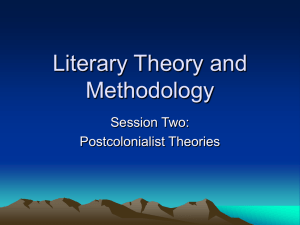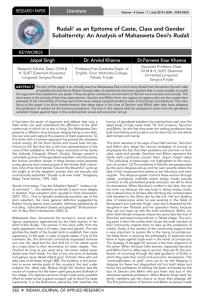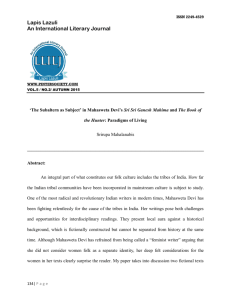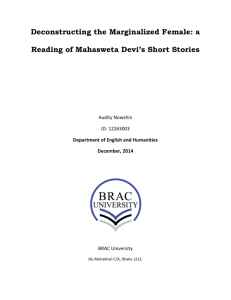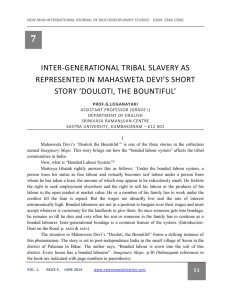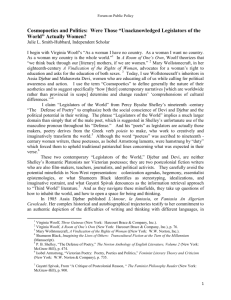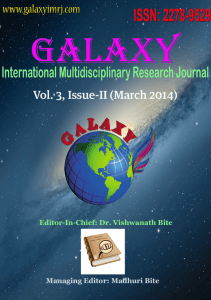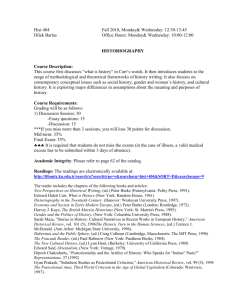Reading Identity and Gender in select Texts of Mahasweta Devi
advertisement
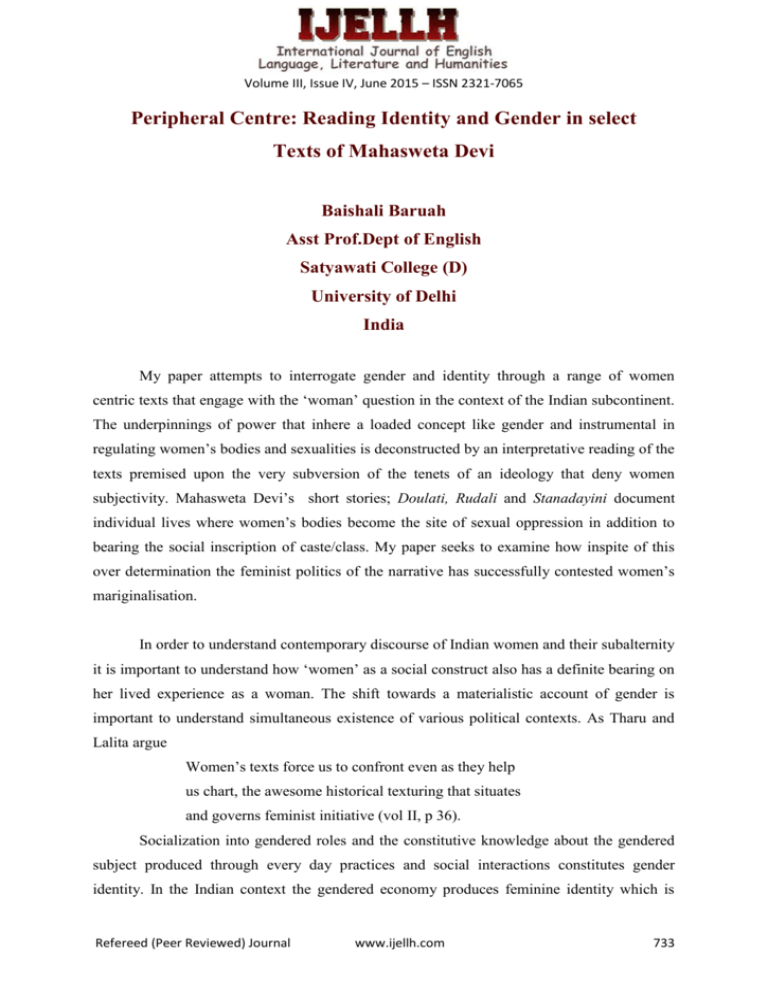
Volume III, Issue IV, June 2015 – ISSN 2321-7065 Peripheral Centre: Reading Identity and Gender in select Texts of Mahasweta Devi Baishali Baruah Asst Prof.Dept of English Satyawati College (D) University of Delhi India My paper attempts to interrogate gender and identity through a range of women centric texts that engage with the „woman‟ question in the context of the Indian subcontinent. The underpinnings of power that inhere a loaded concept like gender and instrumental in regulating women‟s bodies and sexualities is deconstructed by an interpretative reading of the texts premised upon the very subversion of the tenets of an ideology that deny women subjectivity. Mahasweta Devi‟s short stories; Doulati, Rudali and Stanadayini document individual lives where women‟s bodies become the site of sexual oppression in addition to bearing the social inscription of caste/class. My paper seeks to examine how inspite of this over determination the feminist politics of the narrative has successfully contested women‟s mariginalisation. In order to understand contemporary discourse of Indian women and their subalternity it is important to understand how „women‟ as a social construct also has a definite bearing on her lived experience as a woman. The shift towards a materialistic account of gender is important to understand simultaneous existence of various political contexts. As Tharu and Lalita argue Women‟s texts force us to confront even as they help us chart, the awesome historical texturing that situates and governs feminist initiative (vol II, p 36). Socialization into gendered roles and the constitutive knowledge about the gendered subject produced through every day practices and social interactions constitutes gender identity. In the Indian context the gendered economy produces feminine identity which is Refereed (Peer Reviewed) Journal www.ijellh.com 733 Volume III, Issue IV, June 2015 – ISSN 2321-7065 constructed around the female body and its sexual reproductive roles. This follows the regulation of female sexuality and the historical subalternity of Indian women feeds into the Marxist conceptualization of women as a „sexual class‟. Mahasweta Devi‟s story Stanadayini attempts to map the space of Joshoda who is caught in the paradox of being elite by caste and a subaltern by class. Joshoda‟s body and the constitutive knowledge around it is what assign her a subject position rather than her conscious self. Such an internalization of hegemonic codes is evident in her declaration to her husband “you are guru. If I forget and say no, correct me. Where after all is the pain? … does it hurt a tree to bear fruit?” (p. 260). The indoctrination of precepts about gender roles is deep-rooted in her psyche and thus her transition from the private to the public sphere is marked by conflict. Hence her outburst: “The man brings, the woman cooks and serves. My lot is inside out … Living off a wife‟s carcass you call that a man?” (p 265). The protagonist represents the dominant ideas so much so that “She never had time to calculate if she could or could not bear motherhood. Motherhood has always been her way of living and keeping alive her world of countless beings” (p.252). However the systematic oppression entailed in the production of „surplus milk‟ produces Jashoda‟s alienation from her breasts. “She thought of her breasts as most precious objects” (p 260). Reflecting on the mind/body dichotomy that the subaltern woman is subjected to Gayatri Spivak remarks „Stanadayini‟ – the giver of the breast, of the alienated means of production, the part-object, the distinguishing organ of the female as mother. The violence of this neologism allows the cancer to become signifier of the oppression of the gendered subaltern. It is the parasite feeding on the breast in the name of affect consuming the body politic (p 132). Here Foucault‟s account of power is useful for analyzing domination (as gender difference is shaped by relations of power) and critiquing normative femininity. The ubiquitous nature of power resides in the fact that power is not always repressive but also productive. As Foucault puts it “power produces, it produces realty, it produces domains of objects and rituals of truth” (1977: p.194). It also according to Foucault produces subjects by simultaneously subjecting them to power. In the light of Foucault‟s position, patriarchy produces knowledge/truth about „wifehood‟, „motherhood‟, „marriage‟ which has a Refereed (Peer Reviewed) Journal www.ijellh.com 734 Volume III, Issue IV, June 2015 – ISSN 2321-7065 normalizing and regulatory function. The power/ knowledge nexus implies that all knowledge about women‟s body sexuality and identity is the effect of specific regimes of power, here patriarchy. Foucauldian power/knowledge principle is useful in deconstructing what is normative femininity as when Mahasweta Devi exposes the sexist economy of exploitation/domination that govern the principle of the divine Mother. Jashoda says, “If you suckle you‟re a mother, all lies.” (p 271). The denigration of the female body leads to a series of denials structured around issues of power, history and politics. Hence I argue that for the gendered subaltern their exclusion/marginalization is compounded by the politics of identity, nationalism, historiography. As Vrinda Nabar puts it ... in India, the discrimination against them (women) would be by large three fold: sex based (Stri Jati), caste based (Jati) and class based. To be caste as woman in India is to live out this triple layered existence (p 50). By foregrounding the sufferings of lower caste women in Douloti and Rudali, the texts dramatizes how women‟s identity is interpolated with the question of caste in a feudal patriarchal structure. Douloti and the bonded prostitutes are related in their exploitation and their implication in the labour/capital mode of production. The collusion of gender ethics and capitalist ethics is evident in Kishanchand‟s declaration “the whorehouse is the factory… You are all labour” (p 69). It is thus the Kamiya whore who are coerced into capitalist economy and yet denied any economic power by the institutionalized prostitution of bonded labour. As Meenakshi Thapan observes the fringed existence of these women is reinforced by a „technology of power‟ that mark them out as „deviants‟ and encode space as „sacred‟ and „profane‟. She quotes Foucault to explain the obsessive preoccupation with sex as expression of gender domination. By ferreting out areas of illicit sexual activity, a new technology of power and „science of sexuality‟ were created that facilitated control over an ever widening circle of human activity. The “new sense of sexuality” identified sex as a public issue (qtd. In Thapan, p 233). The feminist consciousness in Mahasweta‟s texts bring out the heterogeneity of the woman question in relation to multiple subjectivities and contexts. They are definite intervention/resistance to women‟s embodiment and are engaged in areas of contestation like Refereed (Peer Reviewed) Journal www.ijellh.com 735 Volume III, Issue IV, June 2015 – ISSN 2321-7065 representation, identity, invisibility within the framework of Indian culture and aim at understanding particularly the gendered subaltern (tribal lower caste women) and evoke diff forms of resistance. Douloti is not a subject of resistance. She comes to terms with her experience by accepting bond-slavery as the law of nature. But in writing the rape into her story Mahasweta Devi reinscribes subjectivity and agency for the mute rape victim. In Douloti Mahasweta Devi employs the textual strategies to counter this determinism. She creates a low-caste raped woman the eponymous subject of narrative. All throughout the focus is on her and the meticulous details of her suffering are often punctuated with feminist commentary on her exploitation. Rudali is a post-rape narrative concerned to show how the Ganju women survive their rapes. They reconstitute subjectivity by taking recourse to alternate profession and deploy the same to regotiate for their sexual violence. As Spivak notes in her commentary on another of Mahasweta‟s is story Draupadi (1978) It is when the female protagonist crosses the sexual differential into the field of what could happen to a woman that she emerges as the most powerful „subject‟ whom the author can describe as a terrifying super object (p168). Rudali offers an account of Ganju women‟s organizing of prostitutes as funeral wailers. Sanichari‟s wailing business can be read as subversive act of reclaiming ownership of their bodies and a reversal of power/dominion formula as when Sanichari claims “The malik now belongs to us” (p 91). Here Rajeswari Sunder Rajan‟s remarks on feminist texts of rape can be co-opted to trace the contours of self-fashioning that turns the raped woman into “a terrible super object”. According to her for women “to speak rape itself is a measure of liberation, a shift from serving as the object of voyeuristic discourse to the occupation of a subject-position as „master‟ of narrative” (p78). To conclude for the women in the text whether it is Jashoda, Doulati or Sanichari, the rethinking of their personal histories afford them intention and continuity which in the post modern discourse constitutes a subject making activity. Their individual stories chart the making of subaltern subject in the interstitial space of the double bond of tradition and modernity in postcolonial India. Refereed (Peer Reviewed) Journal www.ijellh.com 736 Volume III, Issue IV, June 2015 – ISSN 2321-7065 WORKS CITED Devi, Mahasweta, “Douloti the Bountiful”. Trans. Gayatri Chakravorty Spivak. Imaginary Maps. New York : Routledge, 1995. Devi, Mahasweta, “Rudali”. Trans Anjum Katyal. Rudali : From Fiction to Performance. Calcutta : Seagull, 1999. Devi, Mahasweta. “Stanadayini”. Trans Gayatri Chakravorty Spivak. Subalten Studies V. Delhi : Oxford University Press. 1987. Foucault, M. Discipline and Punish, Birth of the prison London : Routledge, 1977 …, The History of Sexuality. Vol 1, Londaon : Allen Lane, 1978. Nabar, Vrinda. Caste as woman, Delhi : Penguin, 1995. Rajan, Rajeswari Sunder. Real and imagined Women, London : Routledge, 1993. Spivak, Gayatri Chakravorty. “Draupadi : Translator‟s Foreword”. Writing and Sexual Difference. Ed Elizabeth Abel. Chicago : University of Chicago Press. 1982. Spivak, Gayatri Chakravorty. “A Literary Represenation of the Subaltern : Mahasweta Devi‟s „Stanadayini”. Subaltern Studies V. Ed. Ranajit Guha. Delhi : Oxford University Press, 1987. Thapan, Meenakshi, ed. Embodiment : Essay on Gender and identity. Delhi : Oxford University Press, 1997. Tharu, Susie and K. Lalita, ed. Women Writing in India : 600 B.C. to the Present. Vol II. Delhi : Oxford University Press, 1993. Refereed (Peer Reviewed) Journal www.ijellh.com 737
